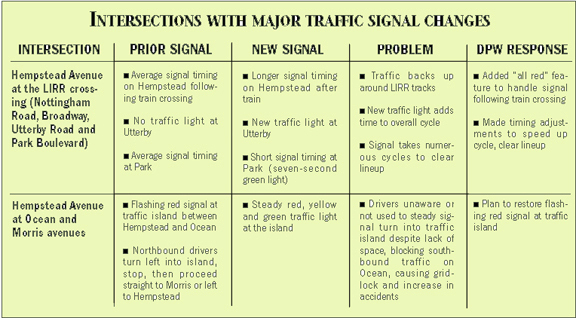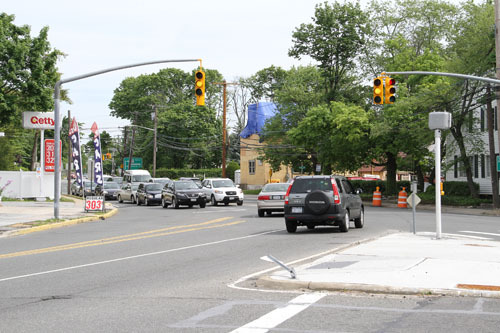Slow and steady traffic drives Malverne mad
New traffic-signal system causes uptick in accidents and gridlock
Sitting in traffic during Malverne’s morning and evening rush hours is bad enough. Waiting for the Long Island Rail Road trains to pass through the village is, at times, irritating. But such delays are expected: After about 40 years of the same traffic patterns, they have become routine.
So it felt like a slap in the face to Malverne residents and officials when the Nassau County Department of Public Works changed its entire traffic-signal system in February. Three months and a handful of fender benders later, village officials say, it is apparent that the unanticipated change was not in the village’s best interests.
Gridlock has been constant, regardless of the time of day or day of the week, according to Police Chief John Aresta. Getting from one part of the village to another, Aresta said, has become a “nightmare,” even on Sundays, and it has caused problems for emergency vehicles that are unable to get through traffic jams. The village has also seen an increase in minor car accidents, mostly resulting from drivers’ confusion or frustration. “People are getting aggravated,” Aresta said, “and that can lead to road rage.”
Officials are also concerned about the new system’s effects on the local economy, fearing that irritated drivers will go elsewhere to shop. “People aren’t going to want to go through Malverne, and ... that could cause a ripple effect for our merchants, and we certainly don’t want that to happen,” said Mayor Patricia McDonald. “And it’s also quality-of-life issues for the people that live on Hempstead Avenue, especially the people that are right by the traffic lights. If you’ve got traffic back at a standstill, especially at this time of year, when you’ve got your windows open, you have cars idling for long periods of time, then you have people honking their horns, screaming and yelling, and all that.”
In addition to the complaints about the new signal system, what’s disconcerting for the mayor is the way the county went about implementing it. In November 2008, just as Malverne finished constructing new sidewalks as part of its downtown revitalization, the DPW began ripping up pavement and removing and replacing traffic signals. The county failed to notify village officials that Malverne was part of the Signal Expansion Project.
Aresta put it simply: “The system wasn’t broken. If it ain’t broke, don’t fix it.”
DPW Commissioner Shila Shah-Gavnoudias said the purpose of the project is to centralize the county’s traffic control. “This will allow better control over the signals as well as allow timing modifications and adjustments to be made from a central location instead of having to visit each field location to control various functions,” Shah-Gavnoudias recently told the Herald.
The project, which connected the signals on three major roadways to a central computer in Westbury, was also intended to improve the county’s communication to and synchronization of the signals. This, according to the commissioner, will make traffic flow more smooth and efficient.
“Conceptually, it sounds wonderful,” said Robert Solarino, superintendent of Malverne’s Building Department. Solarino said there was a need for new infrastructure — like traffic light poles with longer arms that improve visibility, and pedestrian crossing signals — because Malverne’s was outdated and aging. There also may have been some need for improvement at certain intersections, but a large-scale, systemwide change was unnecessary, Solarino said.
“We know what works best in Malverne — Nassau County doesn’t,” Aresta said of the county’s decision not to solicit village input on the matter. “Who better to tell you what’s going on than the people who are here every day?”
The DPW insists that centralization of the traffic-control system will improve roadway movement throughout the county.
At a village board meeting earlier this month, trustees told DPW Deputy Commissioner Ray Stefanowicz that they wanted the old system back. At the very least, they said, adjustments need to be made in a number of locations where the new system has caused problems. Stefanowicz said that repairs would be made within six to eight months, when the county anticipates completion of all construction on the project, which also includes East Rockaway, Glen Cove and West Hempstead.
Unwilling to accept that timetable, McDonald met with Shah-Gavnoudias earlier this month and asked that action be taken immediately. Since then the village has seen some improvements, but they are not enough, according to McDonald. “We want traffic to start flowing the way it was prior to the county coming in,” she said.
While the county will not agree to reinstall the old signal system, it is re-examining traffic control in the village and making adjustments to restore a more efficient flow, according to the DPW commissioner. “We have been working on this issue all along and promptly responding to the village complaints,” she said. “It is a very complicated setup that needs some trial and error to find what works best. That is why the citizens were seeing what they consider to be new timing that doesn’t work for them. The operation is believed to be much better now.”
But it is still not what many residents want. “It’s very frustrating because our hands are tied,” McDonald said. “We’re at the mercy of the county.”
Comments about this story? LLandor@liherald.com or (516) 569-4000 ext. 205.

 59.0°,
Mostly Cloudy
59.0°,
Mostly Cloudy 







